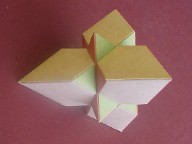
In my Polyhedra page, I posed the following problem regarding this
polyhedron:
What proportion of this solid's volume is occupied
The key to an elegant solution is to realize that if the dimensions
of an object are multiplied by a factor of x, its volume is
multiplied by a factor of x3 (x cubed).
If you blow up a spherical balloon to a certain diameter, it will have a
certain volume. If you then blow it up further until you have doubled its
diameter, the volume will be multiplied by 8 (i.e. 2 cubed). If you then
blow it up so that its diameter is three times its original diameter, its
volume will be 27 (i.e. 3 cubed) times its original volume; and so on.
If the balloon is any other shape than spherical, this will still be true.
As long as the shape doesn't change, the same principle applies.
Now consider a regular tetrahedron. Define its edge-length to be one "length
unit", and its volume to be one tetrahedral "volume unit". (By doing this,
we avoid having to worry about the formula for the volume of a tetrahedron
in terms of its edge-length. We simply make the tetrahedron the basic solid
shape for defining volumes, instead of the cube.) If you increase the
tetrahedron's dimensions by a factor of 3 (to 3 length units), its volume
will increase to 27 volume units.
If you then truncate this "triple-size" tetrahedron by slicing off its
corners one-third of the way along its edges, each of the four truncated
pieces is a small tetrahedron with a volume of one volume unit. So the
truncated tetrahedron has a volume of (27-4) = 23 volume units.
Now consider the polyhedron depicted above, which is generated by stellating
a truncated tetrahedron. In addition to regenerating the four truncated
corners (each with a volume of one volume unit), those four odd-shaped large
pieces are generated, one over each of the four hexagonal planes of the
truncated tetrahedron.
The original truncated tetrahedron and those four large pieces together form
a large tetrahedron with a small gap along each of its six edges (each with
a volume of one volume unit). The edge-lengths of this large tetrahedron are
each 5 length units; thus its volume (ignoring the gaps for the moment) is
125 (i.e. 5 cubed) volume units.
Thus the volume of the entire polyhedron is (125-6+4) = 123 volume units.
(The -6 is to allow for the gaps, and the +4 accounts for the regrown
corners of the truncated tetrahedron.)
It follows that the truncated tetrahedron's volume is 23/123, or 0.187 (to
three decimal places), of the polyhedron's total volume.
It should be noted that this approach only works because "bits missing" and
"bits added" at various stages are all the same shape (i.e. tetrahedral in
this case). For a polyhedron in which this was not true, you'd have
to resort to the "donkey-work" approach - at least to some extent.
My home page
Preliminaries (Copyright, Safety)
First stellation of the truncated tetrahedron: volume



by the truncated tetrahedron at its centre?
I mentioned that this problem can be solved without knowing the formula for
the volume of a pyramid, or even the formula for the area of a triangle.



 Return to Polyhedra page
Return to Polyhedra page

